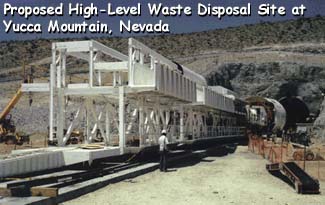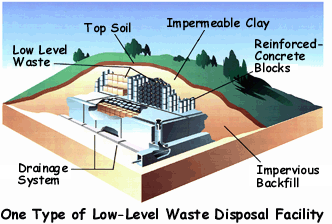|
Home
> Electronic Reading
Room
> Basic
References
> Radioactive Waste
Radioactive Waste


|
Nuclear power plants generate two types of waste:
High-level
and Low-level. |
High level waste consists of spent - or used -
nuclear fuel. This type of fuel is highly radioactive because it
contains the fission byproducts that were created while the reactor
was operating. Some of these fission products will take many years
to decay (called half-life), or lose their radioactivity. A special
disposal site is needed for this type of spent fuel, so the
Department of Energy is building a high-level waste disposal site at
Yucca Mountain, Nevada. The waste must remain isolated for thousands
of years. The NRC must approve and license this site.
|
 |
 |
Low-level waste can come from nuclear reactors or other users of
radioactive material, like hospitals or research institutes.
Low-level waste is less hazardous than high-level waste, and can be
shipped to disposal facilities where it is packaged, buried in
trenches, and covered with soil. States have responsibility for
selecting new disposal sites, or using those already existing. |
Although nuclear power provides about 20% of our nation's
electricity, and nuclear materials assist in thousands of medical
procedures and dozens of industrial applications, many scientists
believe we have not yet discovered all the uses for nuclear
materials. The Nuclear Regulatory Commission will be closely
regulating any peaceful use for nuclear material, assuring public
health and safety, and the protection of the
environment.
|
|
STILL HAVE QUESTIONS? |
| ASK A SCIENTIST FOR THE ANSWER! E-mail us at OPA@NRC.GOV and someone from the
NRC will try to help you! |
 | |
 | |

